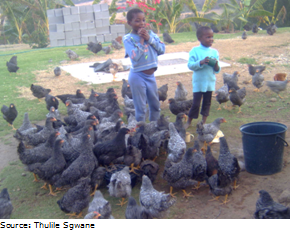BackgroundRural area poultry accounts for more than 60% of the total national poultry population
in most African countries (Sonaiya et al. 1990). Village or indigenous The high prevalence of diseases in poultry has led to the introduction of a wide range of antibiotics. However, sub-therapeutic use of antibiotics in poultry feeds has become undesirable due to possible residuals effects in animal products leading to antibiotic resistance in humans. An alternative to the use of antibiotics is the use of probiotics which have been shown to improve performance in terms of weight gain, feed conversion efficiency and reduced mortality (Lange 2007). Spent yeast (Saccharomyces cerevisiae) is one of the probiotics being mostly researched. Probiotics are live microbial feed supplements that beneficially affect the host animal by improving its intestinal balance, leading to resistance to disease and lower mortality rates, especially during the first week of life (Gibson and Fuller 2000). |
 chickens are more widely distributed in rural Africa
than other livestock species (
chickens are more widely distributed in rural Africa
than other livestock species (